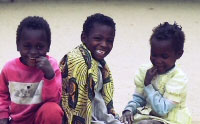 |
 |
 |
 |
|
 |
| Street children |
 |
| According to UN sources there are up to 150 million street children in the world today. Chased from home by violence, drug and alcohol abuse, the death of a parent, family breakdown, war, natural disaster or simply socio-economic collapse, many destitute children are forced to eke out a living on the streets, scavenging, begging, hawking in the slums and polluted cities of the developing world. |
 |
Various categories of street children exist. There are those who work on the streets as their only means of getting money, those who take refuge on the streets during the day but return to some form of family at night and those who permanently live on the street without a family network. All are at risk from abuse, exploitation and vigilante or police violence, but the most vulnerable are those who actually sleep and live on the streets, hiding under bridges, in gutters, in railway stations. While they may have small jobs such as shoe-shining or market-selling to pull through, many also end up dying on the pavement, victims of drugs, gang rivalry and disease. Without some form of basic education and economic training, the future is bleak for these street children and their life expectancy terrifyingly low.
How does one bring education to these children who are often treated as criminals and wary of institutions, authority and organised activities? They can see the adult world as inherently threatening. Non-formal education is one way to address these legitimate concerns, while leaving the door open to mainstream education later on. The range of non-formal initiatives for street children is vast. Methods vary from using dance, music and sports to circus and art. Some of these practices supported by UNESCO now form part of the Programme for the Education of Children in Need.
For an overview of current projects, select a region from the list below:
Since 1992, joint projects for street children have been carried out in the following countries:
Bangladesh, Benin, Burkina Faso, Cambodia, Cameroon, Colombia, Costa Rica, Dominican Republic, Ecuador, Ethiopia, Germany, Ghana, Haiti, India, Kenya, Lithuania, Mali, Mauritius, Mongolia, Morocco, Namibia, Pakistan, Palestinian Autonomous Territories, Paraguay, Peru,
Philippines, Poland, Romania, Russia, Senegal, Serbia, South Africa, Sri-Lanka, Thailand, Togo, Tunisia, Uganda, Vietnam, Zambia, Zimbabwe.
Photo: © UNESCO/F.A. Morrard |
 |
|
 |


